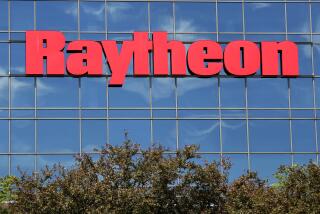U.S. to Help Pay for Toxic Cleanup at Lockheed Plant
- Share via
The U.S. government agreed to reimburse Lockheed Martin for at least $155 million for toxic cleanup costs stemming from decades of manufacturing at the firm’s Burbank defense facilities, according to documents filed in federal court Thursday.
Under the 29-page agreement signed by U.S. District Judge Mariana R. Pfaelzer, the government will pay half of the $265 million Lockheed Martin has paid out since 1992 to clean up contaminated ground water and soil in Burbank.
Federal officials also agreed to assume half of the estimated $110 million cost the Bethesda, Md.-based defense firm will incur over the next 20 years to clean water supplies under the city.
Lockheed first filed its claim to recover cleanup costs in 1997. The company alleged that the federal government took control of its Burbank site--known as Air Force Plant 14--during World War II and owned and operated the facility until 1973.
The company maintained in its suit that federal officials exercised daily control over operations at the site as Lockheed Martin employees worked on top-secret military projects including the Stealth fighter.
“The bottom line is that we have funded all of the cleanup efforts at our Burbank facilities,” said Lockheed Martin spokeswoman Gail Rymer. “Now the government, which owned and sponsored a majority of the defense work there, is paying its fair share.”
A spokeswoman for the U.S. Justice Department, one of the signatories to the agreement, said it was appropriate for the government to take responsibility for the costs associated with cleanup.
“We think this is a fair settlement,” said Christine Romano, a Justice Department spokeswoman. “It’s not unusual for the government for pay cleanup costs associated with its defense activities.”
Lockheed Corp., the forerunner of Lockheed Martin, was established in Burbank in 1928. It employed nearly 100,000 people at its peak and churned out aircraft for World War II and the Cold War including the P-38 fighter, the U-2 the SR-71 Blackbird spy planes and the F-117A Stealth fighter. It was the home of the legendary “Skunk Works,” which designed advanced military planes.
In 1980, cancer-causing compounds were found in the water and soil beneath the company’s industrial sites in Burbank. Eight years later, after extensive monitoring and testing, federal, state and local agencies determined that the water was undrinkable and the soil toxic.
The defense contractor and other companies agreed in 1992 to pay $265 million to clean up toxic compounds originally used as solvents such as perchloroethylene (PCE) and trichloroethylene (TCE).
Lockheed, in a settlement with federal and state authorities, admitted no wrongdoing but agreed to pay for a water treatment facility for Burbank’s underground water supply. Later this year, the water treatment facility will be owned and run by Burbank, with Lockheed, the other businesses and now the federal government continuing to pay the cost.
Hundreds of residents blame Lockheed for alleged health problems and declining property values they attribute to the now-closed facility’s discharge of carcinogens and other hazardous substances into the ground, air and water.
In 1996, Lockheed and more than 1,300 current or former city residents reached a confidential out-of-court settlement estimated at about $60 million.
Another 3,000 lawsuits have been filed in state court by individual residents who allege they were sickened by chemicals used at the plant.
Alan Sigel, one of the attorneys representing plaintiffs who have sued Lockheed in Burbank said Lockheed shared far more than 50% of responsibility for the contamination and injuries resulting from defense activities.
“I’m pleased Lockheed’s struggle with the government has concluded,” Sigel said “but the battle is far from over.”
More to Read
Inside the business of entertainment
The Wide Shot brings you news, analysis and insights on everything from streaming wars to production — and what it all means for the future.
You may occasionally receive promotional content from the Los Angeles Times.










